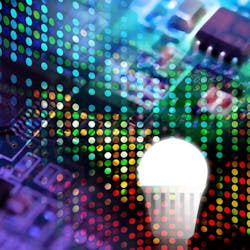Eaton demonstrates distributed DC power for LED lighting at LFI
A Distributed Low Voltage Power architecture that carries power and control to LED luminaires is a new initiative for Eaton and the company will seek to standardize the approach.
Eaton has utilized the LightFair International (LFI) event to demonstrate a new way to power and control LED-based lighting. The Distributed Low Voltage Power (DLVP) architecture includes centralized power conversion for efficiency and a DC distribution scheme. Moreover, the power cables and connectors also carry control data. Eaton will utilize the DLVP platform as an option in its solid-state lighting (SSL) portfolio while also seeking to standardize the approach and allow other lighting manufacturers to leverage DLVP.
Interested in more articles & announcements on power & controls?
We have covered the concept of DC power distribution for lighting for several years and published a comprehensive feature on the topic a couple of years back. Powering a building- or floor-level lighting system with DC can further boost the efficiency of already-efficient LED lighting by centralizing the power-wasting AC/DC conversion. Moreover, the move to DC enables simpler wiring that often does not require the services of an electrician.
Most recently, it has been the Power-over-Ethernet (PoE) scheme that has received the most attention with the technology both connecting and powering LED luminaires. Eaton, it should be noted, supports the PoE concept and is a partner in the Cisco Digital Ceiling initiative.
Still, Ken Walma, vice president and general manager of ambient and controls solutions at Eaton, said the choice of DC distribution technology will depend on application. And Walma believes the DLVP concept will serve perfectly in many applications.
Eaton has selected cable and connectors for DLVP that will carry the DC power and data. DLVP-enabled systems will be inherently connected. Luminaires will carry a lightweight DC/DC converter to deliver the constant current needed for precise control of light output. The DC power can be daisy chained or connected in a star configuration.
Initially, Eaton will supply 300W and 600W power units. The power will be distributed over 100W channels. Connections can be handled without an electrician. And if someone connects too many loads to a channel, the controller will signal the error condition automatically. Each DC/DC converter must be able to communicate its load to the power unit. The central unit has additional ports for sensors and controls.
Eaton said the DC approach can reduce the installation and materials cost of a lighting system by 40%. The LFI demo had an exaggerated view of a typical ceiling with a spiderweb of conduit and wiring. The DLVP system needs no conduit and the daisy-chaining approach minimizes wiring.
It will be interesting to see if Eaton can convince other lighting manufacturers to utilize the DVLP system. Walma said Eaton would freely encourage usage even by competitors. Still, there are many other DC power schemes on the market including the Emerge Alliance of which Eaton was an early member, and Emerge was also exhibiting at LFI. Of course, Emerge has been pushing the DC concept for more than five years with somewhat tepid success.
In the coming days, watch our website for our video interview with Walma at LFI.

Maury Wright | Editor in Chief
Maury Wright is an electronics engineer turned technology journalist, who has focused specifically on the LED & Lighting industry for the past decade. Wright first wrote for LEDs Magazine as a contractor in 2010, and took over as Editor-in-Chief in 2012. He has broad experience in technology areas ranging from microprocessors to digital media to wireless networks that he gained over 30 years in the trade press. Wright has experience running global editorial operations, such as during his tenure as worldwide editorial director of EDN Magazine, and has been instrumental in launching publication websites going back to the earliest days of the Internet. Wright has won numerous industry awards, including multiple ASBPE national awards for B2B journalism excellence, and has received finalist recognition for LEDs Magazine in the FOLIO Eddie Awards. He received a BS in electrical engineering from Auburn University.





